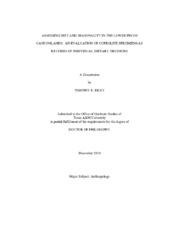| dc.description.abstract | This dissertation presents an evaluation of coprolite specimens from the Lower
Pecos canyonlands as records of individual dietary decisions. Prior studies of coprolites
from this region have greatly expanded our knowledge of Archaic subsistence patterns,
but have not taken full advantage of the record of individual dietary decisions recorded
in each coprolite specimen. The menu, or dietary combinations, reflected in individual
coprolite specimens are assessed through the identification of several congruent
botanical components derived from the same food resource, phytoliths, fiber ultimates,
and epidermal sheets. The data is analyzed with hierarchical cluster analysis, an
exploratory statistical technique. The resultant menus reflected in these clusters are
evaluated with reference to the diet-breadth model developed for the known staple
resources of the canyonlands as well as the seasonal subsistence patterns observed in the
ethnohistoric record of modern-day Mexico and Texas. This same technique is also
applied to the coprolite data available from previous studies in the Lower Pecos
canyonlands.
Overall, the combined dietary data available for the Lower Pecos canyonlands
presents a similar dependence on desertic plant resources throughout the Archaic. Three
main menus are apparent in the specimens. The first menu consists of prickly pear
(Opuntia sp.) cladodes, or nopales, and was principally, although not exclusively,
consumed in the late spring. This menu is primarily consumed when other resources
were not readily available and may be considered a dependable but undesirable meal.
The second menu consists of pit-baked lechuguilla (Agave lechuguilla) and sotol
(Dasylirion sp.) caudices, or hearts, common throughout the cool season. This menu
entails high processing costs, but would provide a reliable caloric return. The third
menu exhibits a monolithic reliance on prickly pear fruits, or tunas, during the summer.
The ease of harvest and consumption is reflected in the seasonal dominance of this
resource, which was assuredly a highly desirable meal. The dietary patterns recorded in
the coprolite specimens from the Lower Pecos canyonlands demonstrate a seasonally
variable diet-breadth that incorporated low-ranked resources during times of seasonal
scarcity as well as a monolithic dependence on high-ranked resources when they were
available in the local landscape. | en |


